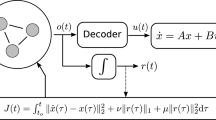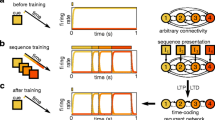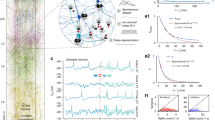Abstract
Despite the vital importance of our ability to accurately process and encode temporal information, the underlying neural mechanisms are largely unknown. We have previously described a theoretical framework that explains how temporal representations, similar to those reported in the visual cortex, can form in locally recurrent cortical networks as a function of reward modulated synaptic plasticity. This framework allows networks of both linear and spiking neurons to learn the temporal interval between a stimulus and paired reward signal presented during training. Here we use a mean field approach to analyze the dynamics of non-linear stochastic spiking neurons in a network trained to encode specific time intervals. This analysis explains how recurrent excitatory feedback allows a network structure to encode temporal representations.








Similar content being viewed by others
References
Amit, D. J. (1989). Modeling brain function: The world of attractor neural networks. Cambridge [England], New York: Cambridge University Press. 89015741 Daniel J. Amit. ill.; 24 cm. Includes bibliographies and index.
Amit, D. J., & Brunel, N. (1997). Model of global spontaneous activity and local structured activity during delay periods in the cerebral cortex. Cerebral Cortex, 7(3), 237–252.
Amit, D. J., Gutfreund, H., & Sompolinsky, H. (1985). Spin-glass models of neural networks. Physical Review A, 32(2), 1007–1018.
Barbieri, F., & Brunel, N. (2008). Can attractor network models account for the statistics of firing during persistent activity in prefrontal cortex? Front Neuroscience, 2(1), 114–122.
Brody, C. D., Romo, R., & Kepecs, A. (2003). Basic mechanisms for graded persistent activity: Discrete attractors, continuous attractors, and dynamic representations. Current Opinion in Neurobiology, 13(2), 204–211.
Brunel, N., & Wang, X. J. (2001). Effects of neuromodulation in a cortical network model of object working memory dominated by recurrent inhibition. Journal of Computational Neuroscience, 11(1), 63–85.
Budd, J. M. (1998). Extrastriate feedback to primary visual cortex in primates: A quantitative analysis of connectivity. Proceedings of the Royal Society B: Biological Sciences, 265(1400), 1037–1044.
Churchland, M. M., Yu, B. M., Cunningham, J. P., Sugrue, L. P., Cohen, M. R., Corrado, G. S., et al. (2009). Stimulus onset quenches neural variability: A widespread cortical phenomenon. Nature Neuroscience, 13(3), 369–378.
Compte, A., Brunel, N., Goldman-Rakic, P. S., & Wang, X. J. (2000). Synaptic mechanisms and network dynamics underlying spatial working memory in a cortical network model. Cerebral Cortex, 10(9), 910–923.
Eliasmith, C. (2005). A unified approach to building and controlling spiking attractor networks. Neural Computation, 17(6), 1276–1314.
Gavornik, J. P. (2009). Learning temporal representations in cortical networks through reward dependent expression of synaptic plasticity. Ph.D. dissertation, The University of Texas at Austin.
Gavornik, J. P., Shuler, M. G., Loewenstein, Y., Bear, M. F., & Shouval, H. Z. (2009). Learning reward timing in cortex through reward dependent expression of synaptic plasticity. Proceedings of the National Academy of Sciences of the United States of America, 106(16), 6826–6831.
Johnson, R. R., & Burkhalter, A. (1996). Microcircuitry of forward and feedback connections within rat visual cortex. Journal of Comparative Neurology, 368(3), 383–398.
Lewis, P. A., & Miall, R. C. (2006). A right hemispheric prefrontal system for cognitive time measurement. Behavioural Processes, 71(2–3), 226–234.
Lisman, J. E., Fellous, J. M., & Wang, X. J. (1998). A role for NMDA-receptor channels in working memory. Nature Neuroscience, 1(4), 273–275.
Machens, C. K., Romo, R., & Brody, C. D. (2005). Flexible control of mutual inhibition: A neural model of two-interval discrimination. Science, 307(5712), 1121–1124.
Mastronarde, D. N. (1987). Two classes of single-input X-cells in cat lateral geniculate nucleus. II. Retinal inputs and the generation of receptive-field properties. Journal of Neurophysiology, 57(2), 381–413.
Mauk, M. D., & Buonomano, D. V. (2004). The neural basis of temporal processing. Annual Review of Neuroscience, 27, 307–340.
Miller, P., Brody, C. D., Romo, R., & Wang, X. J. (2003). A recurrent network model of somatosensory parametric working memory in the prefrontal cortex. Cerebral Cortex, 13(11), 1208–1218.
Moshitch, D., Las, L., Ulanovsky, N., Bar-Yosef, O., & Nelken, I. (2006). Responses of neurons in primary auditory cortex (A1) to pure tones in the halothane-anesthetized cat. Journal of Neurophysiology, 95(6), 3756–3769.
Renart, A., Brunel, N., & Wang, X. (2003). Mean-field theory of irregularly spiking neuronal populations and working memory in recurrent cortical networks. In J. Feng (Ed.), Computational neuroscience: A comprehensive approach (pp. 431–490). Boca Raton: CRC Press.
Renart, A., Moreno-Bote, R., Wang, X. J., & Parga, N. (2007). Mean-driven and fluctuation-driven persistent activity in recurrent networks. Neural Computation, 19(1), 1–46.
Roudi, Y., & Latham, P. E. (2007). A balanced memory network. PLoS Computational Biology, 3(9), 1679–1700.
Seung, H. S. (1996). How the brain keeps the eyes still. Proceedings of the National Academy of Sciences of the United States of America, 93(23), 13339–13344.
Seung, H. S., Lee, D. D., Reis, B. Y., & Tank, D. W. (2000). Stability of the memory of eye position in a recurrent network of conductance-based model neurons. Neuron, 26(1), 259–271.
Shouval, H. Z., & Gavornik, J. P. (2010). A single cell with active conductances can learn timing and multi-stability. Journal of Computational Neuroscience. doi:10.1007/s10827-010-0273-0.
Shuler, M. G., & Bear, M. F. (2006). Reward timing in the primary visual cortex. Science, 311(5767), 1606–1609.
Staddon, J. E. (2005). Interval timing: Memory, not a clock. Trends in Cognitive Sciences, 9(7), 312–314.
Super, H., Spekreijse, H., & Lamme, V. A. (2001). A neural correlate of working memory in the monkey primary visual cortex. Science, 293(5527), 120–124.
Wang, X. J. (2001). Synaptic reverberation underlying mnemonic persistentactivity. Trends in Neurosciences, 24(8), 455–463.
Author information
Authors and Affiliations
Corresponding author
Additional information
Action Editor: Nicolas Brunel
Rights and permissions
About this article
Cite this article
Gavornik, J.P., Shouval, H.Z. A network of spiking neurons that can represent interval timing: mean field analysis. J Comput Neurosci 30, 501–513 (2011). https://doi.org/10.1007/s10827-010-0275-y
Received:
Revised:
Accepted:
Published:
Issue Date:
DOI: https://doi.org/10.1007/s10827-010-0275-y




